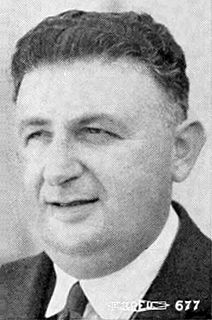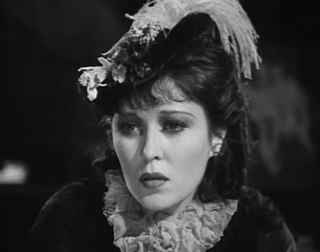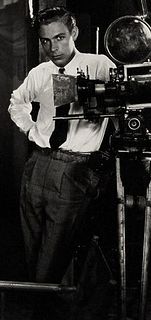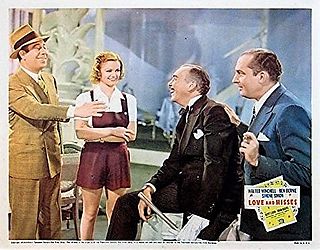Related Research Articles

Walter Winchell was a syndicated American newspaper gossip columnist and radio news commentator. Originally a vaudeville performer, Winchell began his newspaper career as a Broadway reporter, critic and columnist for New York tabloids. He rose to national celebrity in the 1930s with Hearst newspaper chain syndication and a popular radio program. He was known for an innovative style of gossipy staccato news briefs, jokes and Jazz Age slang. Biographer Neal Gabler claimed that his popularity and influence "turned journalism into a form of entertainment."

Charles G. Rosher, A.S.C. was a two-time English-born Academy Award-winning cinematographer who worked from the early days of silent films through the 1950s.

Frederick A. YoungOBE, BSC was a British cinematographer. He is probably best known for his work on David Lean's films Lawrence of Arabia (1962), Doctor Zhivago (1965) and Ryan's Daughter (1970), all three of which won him Academy Awards for Best Cinematography. He was often credited as F. A. Young.
Henry A. Stradling, A.S.C. was an American cinematographer with more than 130 films to his credit.

Lee Garmes, A.S.C. was an American cinematographer. During his career, he worked with directors Howard Hawks, Max Ophüls, Josef von Sternberg, Alfred Hitchcock, King Vidor, Nicholas Ray and Henry Hathaway, whom he had met as a young man when the two first came to Hollywood in the silent era. He also co-directed two films with legendary screenwriter Ben Hecht: Angels Over Broadway and Actor's and Sin.
Joseph Francis Biroc, ASC was an American cinematographer. He was born in New York City and began working in films at the Paragon Studios in Fort Lee, New Jersey. After working there for approximately six years, he moved to Los Angeles. Once in Southern California, Biroc worked at the RKO Pictures movie studio. During World War II, he served in the U.S. Army Signal Corps, and filmed the Liberation of Paris in August 1944. In 1950, Biroc left RKO Pictures and freelanced on projects at various studios. In addition to his film work, which included It's a Wonderful Life (1946) and The Flight of the Phoenix (1965), Biroc worked on various television series, including the Adventures of Superman and Wonder Woman. He frequently collaborated with film director Robert Aldrich.

Karl W. Freund, A.S.C. was an Austrian cinematographer and film director best known for photographing Metropolis (1927), Dracula (1931), and television's I Love Lucy (1951-1957). Freund was an innovator in the field of cinematography and is credited with the invention of the unchained camera technique.
Victor Milner, A.S.C. was an American cinematographer. He was nominated for ten cinematography Academy Awards, winning once for 1934 Cleopatra. Milner worked on more than 130 films, including dramas, comedies, film noir, and Westerns. He worked for large production companies like Metro-Goldwyn-Mayer, Universal, and Paramount during his film career.
Walter C. Pfister is an American director and former cinematographer, who is best known for his work with filmmaker Christopher Nolan. Some of his collaborations with Nolan include Memento (2000), The Dark Knight Trilogy (2005–2012), and Inception (2010). For his work on Inception, Pfister won an Academy Award for Best Cinematography and received a BAFTA Award nomination.

John Peverell Marley was an American cinematographer. He is one of only six cinematographers to have a star on the Hollywood Walk of Fame.
John Alcott, BSC was an English cinematographer known for his four collaborations with director Stanley Kubrick: 2001: A Space Odyssey (1968), for which he took over as lighting cameraman from Geoffrey Unsworth in mid-shoot, A Clockwork Orange (1971), Barry Lyndon (1975), the film for which he won his Oscar, and The Shining (1980). Alcott died from a heart attack in Cannes, France, in July 1986; he was 55. He received a tribute at the end of his last film No Way Out starring Kevin Costner.

Edward Sedgwick was an American film director, writer, actor and producer.

Erin O'Brien-Moore was an American actress. She created the role of Rose in the original Broadway production of Elmer Rice's Pulitzer Prize-winning play, Street Scene (1929), and was put under contract in Hollywood and made a number of films in the 1930s. Her promising career on the stage and screen was interrupted by severe injuries she sustained in a 1939 fire. Following her recovery and extensive plastic surgery she returned to the stage and character roles in films and television, including four seasons of the primetime serial drama Peyton Place (1965–68).
Edward Snyder, also known as Edward J. Snyder, was an American cameraman, cinematographer, and visual effects/special effects artist. Born in New York City in 1895, Snyder would break into the film industry as the Director of Photography on the 1926 silent film, The Fighting Marine, which featured the only screen performance by boxing heavyweight champion, Gene Tunney. He would be one of the plethora of talented cameramen to work on the Howard Hughes' 1930 aerial classic, Hell's Angels, along with such other notable cameramen and future directors of photography, Paul Ivano, Henry Cronjager and Ernest Laszlo. But it was as special effects artist that he would have his greatest success, working on such classic films as Otto Preminger's Laura; George Cukor's Winged Victory; The Keys of the Kingdom, starring Gregory Peck; Elia Kazan's A Tree Grows in Brooklyn; Anna and the King of Siam, starring Irene Dunne and Rex Harrison; and 1948's Deep Waters, for which he was nominated for an Academy Award. Snyder died in 1982.

Edward Cronjager was an American cinematographer, whose career spanned from the silent era through the 1950s. He came from a family of cinematographers, with his father, uncle, and brother all working in the film industry behind the camera. His work covered over 100 films, and included projects on the small screen towards the end of his career. He filmed in both black and white and color mediums, and his work received nominations for seven Academy Awards over the span of three decades, although he never won the statue.
Henry Freulich was an American cinematographer for 31 years. He was married to the actress Kay Harris.

Henry Cronjager was a cinematographer during the early days of silent film, and was active during the beginning of the sound film era.

Love and Hisses is a 1937 American musical comedy film directed by Sidney Lanfield and starring Walter Winchell, Ben Bernie and Simone Simon. It is the sequel to the film Wake Up and Live. Twentieth Century Fox's Darryl F. Zanuck wanted to continue the series with further films, but Winchell chose to return to New York to concentrate on his newspaper and radio work.

Frank Redman was an American cinematographer from the end of the silent era through the 1960s. During his almost 40-year career, he shot over 60 feature films, as well as several film shorts and serials. In the 1950s, he transitioned to the smaller screen, where he was most well known for his work on the iconic television show, Perry Mason from the end of the 1950s through 1965.
William Cronjager was an American cinematographer who worked primarily in the television medium. The son, nephew and grandson of famous cinematographers, he began his career as an assistant cameraman, assisting on the 1957 film Oh, Men! Oh, Women!. In the 1960s he moved to the small screen, where he did the bulk of his work over the next two decades, beginning as the director of photography (DP) for the final three seasons (1967-1969) of the television melodrama, Peyton Place. While working as the DP for the first two seasons of the hit television drama Hill Street Blues, he won an Emmy for the premier episode, "Hill Street Station".
References
- ↑ "Henry Cronjager". American Film Institute. Retrieved August 16, 2020.
- ↑ "Henry Cronjager, Jr". imdb.com. Retrieved August 16, 2020.
- ↑ "Henry Cronjager". imdb.com. Retrieved August 16, 2020.
- ↑ "Walter Winchell On Broadway". Courier-Post . February 26, 1937. p. 17. Retrieved August 16, 2020– via Newspapers.com.

- ↑ "Wake Up and Live". American Film Institute. Retrieved August 16, 2020.